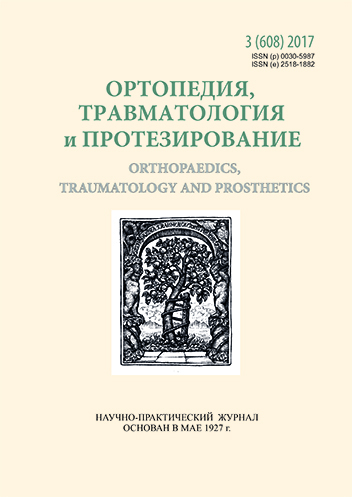Optimization of treatment of patients with inflammatory-destructive diseases of the spine and joints, taking into account specific immunological parameters
DOI:
https://doi.org/10.15674/0030-59872017368-72Keywords:
tissue and bacterial sensitization, osteochondrosis, coxarthrosis, gonarthrosis, lymphocytotoxic antibodiesAbstract
Objective: to study general and specific indicators of the immune status in patients with inflammatory and destructive diseases of the spine and joints, to assess relationships of established immunological features and capabilities of their therapeutic correction.
Methods: the study involved 20 men and 17 women (average age (68.7 ± 2.61) years) with inflammatory-destructive diseases of spine and joints II–III stage (osteochondrosis, coxarthrosis, knee joint osteoarthrosis). We determined the levels of CD3+, CD4+, CD8+ lymphocytes, autoimmune lymphocytotoxic and granulocytotoxic antibodies, circulation immune complexes, IgA, IgM, IgG, production of leukocyte migration inhibition factor.
Results: reduced levels of cytotoxic T-lymphocytes, increased levels of IgM and leukocyte migration inhibition factor in the presence of bacterial antigens (St. aureus, Str. pyogenes, E. coli, Ps. aeruginosa) were detected. We revealed a strong correlation between the levels of leukocyte migration inhibition factor to bacterial antigens and antigens of connective tissue, indicating that while the disease course the immune response against infectious agent contributes to autoimmune reactivity against host tissues. It is noted that the decrease in production of leukocyte migration inhibition factorin the presens of connective tissue antigens in the case of II–III stage of disease is due to the participation of lymphocytotoxic autoimmune antibodies. A method of in vitro selection immunomodulators for sorption of excessive amounts of lymphocytotoxic autoimmune antibodies t o suppress a utoimmune t issue r esponse b y the h umoral type causing the inflammatory effects of edema and pain.
Conclusions: determination of autoimmune lymphocytotoxic antibodies and leukocyte migration inhibition factor to bacterial antigens, in addition to diagnostic capabilities, is a therapeutic measure of individual selection of drugs in patients with inflammatory and destructive diseases of the spine and joints.References
- Korzh M, Dedukh N, Goridova L, Pobel Ye, Romanenko K, Doluda Ya Alphacalcidol in bone regeneration. Orthopаedics, Тraumatology and Рrosthetics. 2013;1:73-83. doi: 10.15674/0030-59872013173-83. (in Russian)
- Tanaka T, Kishimoto T. The biology and medical implications of interleukin-6. Cancer Immunol Res. 2014;2(4):288–93. doi: 10.1158/2326-6066. CIR-14-0022.
- Delevsky YuP, Khvisyuk AN, Zarzhetskaya NA. Features of the immunological status in various forms of hip-spine syndrome. Orthopаedics, Тraumatology and Рrosthetics. 1999;4:94-8. (in Russian)
- Shaibonov BB, Baronets Vyu, Panchenko LF, Kuabtiev AA. A method for determining of circulating immune complexes. Pathogenesis. 2013;11(1):74-9. (in Russian)
- Verma P, Bhattacharya SN, Banerjee BD, Khanna N. Oxidative stress and leukocyte migration inhibition response in cutaneous adverse drug reactions. Indian Journal of Dermatology, Venerology and Leprology. 2012;78(5):664. doi: 10.4103/0378-6323.100519.
- Isaeva AD, Novachenko TM, Delevsky YuP, et al. Prevention and treatment of miscarriage and leukocyte incompatibility: method. Recommendation. 1975. 19 p. (in Russian)
- Yukitake H, Takizawa M, Kimura H. Macrophage migration inhibitory factor as an emerging drug target to regulate antioxidant response element system. Oxid Med Cell Longev. 2017;2017:8584930. doi: 10.1155/2017/8584930.
- Kim KW, Kim HR. Macrophage migration inhibitory factor: a potential therapeutic target for rheumatoid arthritis. Korean J Intern Med. 2016 Jul;31(4):634-42. doi: 10.3904/kjim.2016.098.
- Florence MM. Migration Stimulating Factor, the search for inhibitors. Doctor of philosophy. University of Dundee. 2013. 395p.
- Tsai TJ. Probing the dose-dependent effect of migration stimulating factor-like drug on fibroblast migration using optical tweezers. Biophysical Journal. 2016;110(3):134a. doi: 10.1016/j.bpj.2015.11.769.
Downloads
How to Cite
Issue
Section
License
Copyright (c) 2017 Mykola Korzh, Frieda Leontyeva, Valentyna Dielievska, Nadiia Zarzhetska

This work is licensed under a Creative Commons Attribution 4.0 International License.
The authors retain the right of authorship of their manuscript and pass the journal the right of the first publication of this article, which automatically become available from the date of publication under the terms of Creative Commons Attribution License, which allows others to freely distribute the published manuscript with mandatory linking to authors of the original research and the first publication of this one in this journal.
Authors have the right to enter into a separate supplemental agreement on the additional non-exclusive distribution of manuscript in the form in which it was published by the journal (i.e. to put work in electronic storage of an institution or publish as a part of the book) while maintaining the reference to the first publication of the manuscript in this journal.
The editorial policy of the journal allows authors and encourages manuscript accommodation online (i.e. in storage of an institution or on the personal websites) as before submission of the manuscript to the editorial office, and during its editorial processing because it contributes to productive scientific discussion and positively affects the efficiency and dynamics of the published manuscript citation (see The Effect of Open Access).














